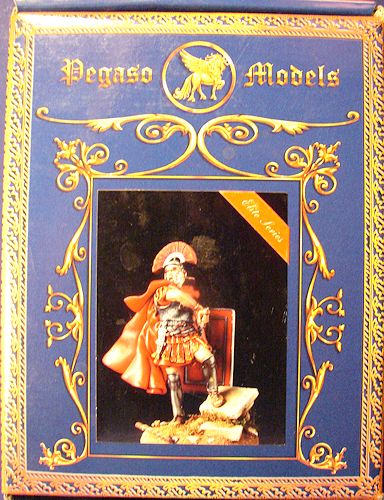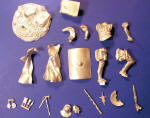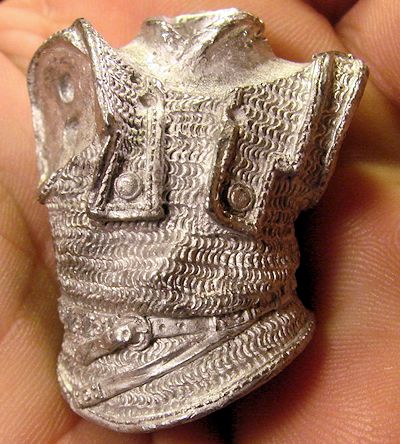
Pegaso 90mm Roman Centurion
| KIT #: | 90-025 |
| PRICE: | $101.00 SRP |
| DECALS: | None |
| REVIEWER: | Mark Hiott |
| NOTES: | Cast Metal |

| HISTORY |
In the Roman infantry, centurions initially commanded a
centuria or
"century". Centuries, or centuriae, developed from the Roman tribal system under
the Servian reforms and could contain 200 to 1000 men. Later, generals and
Caesars further manipulated these numbers with double and half-strength units.
Gaius Julius Caesar, for instance, made the first century double strength.
During the Imperial era, centurions gradually rose in seniority in their cohort,
commanding centuries with higher precedence, until commanding the senior century
and therefore the whole cohort. The very best centurions were then promoted to
become centurions in the First Cohort, called Primi Ordines, commanding
one of the ten centuries and also taking on a staff role. The most senior
centurion of the legion was the Primus Pilus who commanded the first
century. All centurions, however senior, had their own allocated century. There
was little difference between the ranks of centurions except for the "Primus
pilus." The Primus Pilus also participated in war councils.
Centurions often suffered heavy casualties in battle, generally fighting
alongside the legionaries they commanded. They usually led from the front,
occupying a position at the front right of the century formation. They could be
identified by the transverse horse-hair crest on top of their helmet, their
metal greaves and (unlike the legionaries) the sword worn on the left, like all
Roman officers. They led and inspired their men by example. They also sought to
display the skill and courage that may have brought them to their rank in the
first place. It is for these reasons that they often suffered a disproportionate
number of casualties.
Evidence suggests that centurions had important social status and held powerful positions in society. They seemed to receive their status according to their rank. On retirement they could be eligible for employment as Lictors.
| THE KIT |
 I saw
this kit at a swap meet and, as it was only $30, picked it up for my next
project. Cast entirely in white metal, the ca
I saw
this kit at a swap meet and, as it was only $30, picked it up for my next
project. Cast entirely in white metal, the ca sting is first rate. There is very
little in the way of mold lines and the detail is stunning, even on the smallest
parts. What surprised me was the weight of the kit... 660 grams or a hefty 1.4
pounds!
sting is first rate. There is very
little in the way of mold lines and the detail is stunning, even on the smallest
parts. What surprised me was the weight of the kit... 660 grams or a hefty 1.4
pounds!
The kit
consists of 22 parts for the figure and 2 for the base. The parts breakdown
seems logical and the fit of the parts is quite nice. At first glance, I can see
that a bit of filler will be required where the legs come together, but only the
front seam will need much work. The underside seam won't really be seen and the
back seam should be covered by the cloak. There are a couple parts that I can
really figure out, but hopefully they will fall into place as the build
progresses.
There are no
instructions, but there is a sheet that gives generic color callouts. The front
of the box has a nice color photo of the finished model. I have noticed from
photos that many of the Centurions had their shields painted up in beautiful
patterns. There is no indication on how to paint the shield in this kit.
| CONCLUSIONS |
Looks
like a very nice kit. Well cast with beautiful detail. Instructions would have
been nice, as it's a bit hard to tell where everything goes from just one photo.
Being cast in white metal along with the lack of instructions, I can't recommend
this to someone as a first kit, but someone with a few figures under their belt
should enjoy it.
The kit is
still listed on the Pegaso website, but it is an Italian company, so you may
want to try and source one locally.
| REFERENCES |
Photos off the internet
October 2013
If you would like your product reviewed fairly and fairly quickly, please contact the editor or see other details in the Note to Contributors.